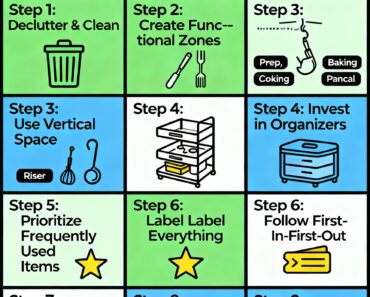Food waste is a significant problem globally, but it starts right in our own kitchens. Throwing away edible food not only wastes money but also contributes to greenhouse gas emissions in landfills. By adopting mindful shopping, storage, and cooking habits, you not only save resources but also make your kitchen routine more efficient and enjoyable.
1. Take a Food Waste Inventory
Start by observing what you tend to throw away. Are there fruits that spoil quickly? Leftover meals regularly discarded? Conducting a simple waste audit for a week helps identify habits to change to reduce waste.
A three-bin system sorting thrown-out food into categories (prep scraps, spoiled items, leftovers) provides clear data on where you lose the most.
2. Plan Meals and Shop Smartly
Meal planning is a frontline defense against buying more than you need:
-
Create weekly meal plans based on what’s in your pantry and fridge.
-
Write and stick to a detailed grocery list to avoid impulse purchases.
-
Buy only the quantities you can realistically consume (consider bulk for staples you frequently use and can store well).
-
Include versatile ingredients that can be repurposed in multiple meals.
-
Avoid shopping hungry to minimize impulse buys.
Smart shopping reduces leftovers and overstock that spoil before use.
3. Practice Proper Food Storage
Correct storage extends your food’s life:
-
Keep your refrigerator at the proper temperature (around 3-4°C or 38-40°F).
-
Use clear, airtight containers for leftovers and prepped ingredients to maintain freshness.
-
Store fruits and vegetables separately; many fruits emit ethylene gas, which accelerates spoilage of nearby vegetables.
-
Learn the optimal storage conditions for common produce (e.g., tomatoes at room temperature, leafy greens in breathable bags).
-
Label containers with contents and dates to use older items first.
4. Use the First In, First Out (FIFO) Method
Arrange your pantry and fridge so older items are at the front and newer purchases placed behind. This simple rotation ensures you use up food before it expires, reducing spoilage.
Make it a habit to check expiration dates during meal planning and grocery restocking.
5. Repurpose Leftovers Creatively
Avoid the fate of forgotten leftovers by turning them into new meals:
-
Transform roast chicken into soups, salads, or sandwiches.
-
Use vegetable scraps for broths.
-
Repurpose stale bread into croutons or breadcrumbs.
-
Use overripe fruits in smoothies, baking, or jams.
This “use-it-all” mindset cuts waste and provides tasty variety.
6. Portion Control While Cooking and Serving
Cooking or serving too much often leads to uneaten food going to waste. Measure portions based on appetite or dietary needs. Serve meals family-style when appropriate so people can take what they want and avoid plate waste.
Save leftovers thoughtfully for next-day meals rather than tossing them prematurely.
7. Compost Organic Waste
While reducing food waste is ideal, unavoidable scraps like peelings, coffee grounds, and eggshells can be composted.
Composting returns nutrients to soil, reduces landfill waste, and supports sustainable gardening. Start a small compost bin indoors or outdoors—there are many easy setups available.
8. Understand Labels and Expiration Dates
“Best before” dates are about quality, not safety. Many foods remain safe to eat after this date if properly stored. Use sensory judgment: look, smell, and taste (safely) to decide if food is still good.
Knowing the difference helps prevent safe food from being thrown away prematurely.
9. Be Mindful of Perishables’ Shelf Life
Shop for perishables like dairy, meat, and fresh produce with careful timing. Buy quantities you’ll use quickly or freeze portions.
Use freezing as an excellent tool for prolonging food life—from bread slices to fruits, meats, and prepared meals.
10. Donate Excess Food
If you have surplus canned or packaged goods nearing expiration, consider donating to food banks or community fridges instead of throwing them out.
Meal leftovers from events or gatherings can often be safely shared with guests or neighbors.
11. Educate and Involve Family Members
Encourage everyone in your household to participate in reducing waste by:
-
Planning meals collaboratively.
-
Using leftovers creatively together.
-
Learning proper storage techniques.
-
Respecting portion sizes.
-
Being conscious when discarding food.
Shared responsibility amplifies effectiveness.
12. Utilize Technology and Tools
Use apps that track pantry items, suggest recipes based on ingredients, or remind you of expiration dates. Digital shopping lists can prevent overbuying.
Smart kitchen tools like vacuum sealers can extend food freshness, reducing spoilage.
Conclusion
Reducing food waste is a practical, rewarding way to save money and protect the environment. By auditing habits, planning wisely, storing properly, repurposing creatively, and involving your family, you build sustainable kitchen practices.
Small changes stack up over time, making your kitchen more organized, efficient, and less wasteful.
This guide consolidates expert advice and practical strategies framed in natural language for clarity and actionability.
Embrace waste reduction as an achievable daily goal—and enjoy the benefits on your wallet and the planet.
- https://www.epa.gov/recycle/preventing-wasted-food-home
- https://www.homebiogas.com/blog/kitchen-waste-disposal/
- https://www.detsi.qld.gov.au/our-department/news-media/down-to-earth/reduce-food-waste-3-easy-tips
- https://www.nutritics.com/en/blog/waste-not-how-to-reduce-kitchen-waste/
- https://www.secondharvest.ca/post/home-chefs-10-ways-to-reduce-your-kitchen-food-waste
- https://www.bbcgoodfood.com/howto/guide/how-reduce-food-waste
- https://www.fda.gov/food/consumers/tips-reduce-food-waste
- https://www.nestleprofessional.com.au/sustainability/10-ways-reduce-food-waste-your-kitchen



